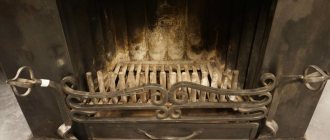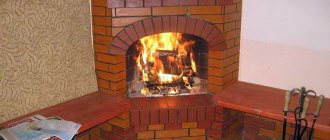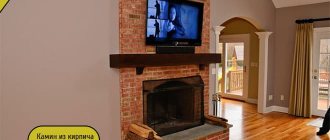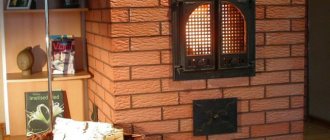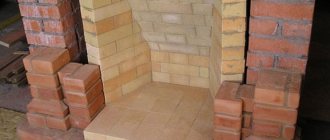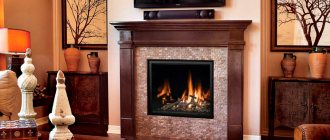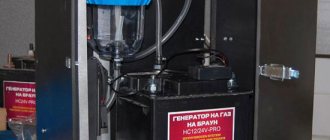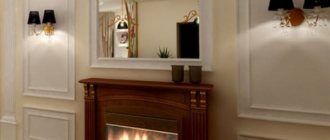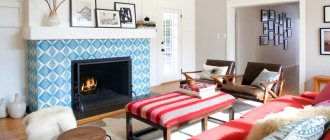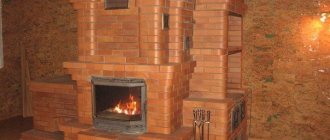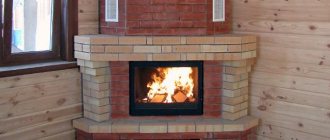A fireplace in a home interior is every homeowner's dream. Unfortunately, certain types of them impose quite serious requirements on the place and method of installation. Thus, a brick wood-burning fireplace cannot be built in an apartment in a multi-story building, and its installation requires a solid foundation due to its enormous mass.
All these disadvantages can be avoided by choosing metal fireplaces as a living hearth. They can be installed in any convenient way and play the role of a source of heat distribution and an excellent decorative item for the room.
Simple but at the same time cute design
Fuel and firebox of a metal fireplace.
The ideal fuel for a metal hearth, as well as for a classic brick one, is firewood from deciduous trees. Coniferous trees emit large amounts of resin, which contaminates the heating device. The use of coal as fuel is strictly prohibited. The combustion temperature of coal is extremely high, this can lead to deformation of the body, rapid failure of the furnace itself, and increases the risk of fire.
The firebox of a metal fireplace is built a little differently. It is divided into two chambers: in one the fuel burns, in the second smoke accumulates. The chambers are separated by a shutter.
The design of the fireplace is elementary, so for a person with welding skills it will not be difficult to weld such a fireplace. The double design of the firebox, like the double walls of the device itself, allows you to receive heat from the metal firebox, warming the cold air between the walls. When you want to assemble a fireplace made of metal, take this circumstance into account.
The stages of manufacturing a fireplace include assembling the chimney. To do this, you need to purchase special stainless steel pipes and elbows. These parts are the main components of the chimney. The pipe parts are connected to each other using sockets. The parts are secured with mastic, which is used for tiling. This is done like this: the end of one pipe, lubricated with mastic, is inserted into another pipe.
If the pipe does not rise straight up, and the exit is located somewhere to the side, so-called elbows are used, which are a kind of turn signals. Using brackets and wire, the pipe is secured to the wall. If the pipe exits through the attic, then the entire “attic” part of the chimney, like the “room” part, is wrapped in thermal insulation, which is a layer of glass wool wrapped with a mesh around the chimney, and a metal casing is put on the mesh.
The prototypes of these stoves were ordinary “potbelly stoves”, which entered our everyday life in the 19th century. Since making a fireplace out of metal is quite within the capabilities of the average Russian, the popularity of these decorative heating units has increased greatly in recent years.
A metal fireplace can be quickly installed. It fits harmoniously into any interior of a country house or cottage. You can also add a fireplace mantel and other attributes of a real brick hearth to such a stove.
In the metal fireplace, the flames also flicker and the wood crackles merrily. It can be called an economical option for a large brick hearth.
Finishing
In absolutely all cases, the resulting fireplace will have to be decorated from the outside. It can simply be coated with a layer of glossy or matte paint. Here you need to remember the elementary laws from the physics course. Dark bodies emit more energy, and since our task is to remove energy, black colors will be a priority.
Good to know: How to properly heat a fireplace with wood, step-by-step instructions and tips from the pros
The fireplace can be finished with special fireproof materials. These include tiles made of ceramics, artificial and natural stone. When gluing tiles, you should remember the thermal expansion of the metal, so the seam gap should be slightly increased.
With the possibility of making your own fireplace, a lot of opportunities open up for you to realize your old dream exactly in the form in which it interprets itself. Desire and work in a certain sequence will ensure an excellent result.
How to lay a stove with your own hands
To prevent mistakes when laying, use order.
Once the foundation is ready, you can begin laying the stove. Before this, it is necessary (if you are not a professional stove maker) to prepare in advance the order of the stove or fireplace. This “document” allows you to determine almost exactly the amount of brick that will be needed for the entire kiln, as well as to prevent any inaccuracies and shortcomings in the masonry process.
The stone oven is made of red refractory bricks. It is also called fireclay. Thanks to special processing, it acquires qualities and characteristics similar to those of natural stone. In addition to bricks, the oven must also consist of a strong mortar that holds the bricks together. You can prepare it yourself using clay, sand, water, cement or lime.
The choice of certain components depends on the quality of clay you use. So, if your clay is normal, then it will be enough just to soak it with water, and such a solution will be suitable for stove masonry. If the clay is oily or skinny, then other elements will need to be added to it. Oily clay will need binders, such as sand, lime or cement. If she is skinny, then you will have to add fatty clay.
http:
https://youtube.com/watch?v=78fqp8T0NoM
How to check the quality of clay with your own hands?
To do this, you will not need to resort to any chemical experiments or other complex tests. All you need is a container of water. You need to put a certain amount of clay into it (no more than half a kilogram). After it softens, it will need to be mixed in water. This is done with a regular stick. It is by looking at it that you will determine how fatty or how thin the clay is. After stirring, take out the stick or paddle and watch. What happened to her? If the clay sticks to the stick in large pieces, then it is greasy, if the layer of clay on it is small, and it slowly slides off, then the clay is normal. Skinny clay does not stick to the stick, and you will take it out of the water in exactly the same condition as when you previously placed it in the liquid.
Another option is to form 2 small balls, one of which will need to be crushed into a cake. Both figures should be placed in a dry, dark place for 2-3 days. There they will dry, and then it will be possible to check what clay they were made from. If there are no cracks on them, then the clay is either thin or normal. You can determine more precisely by hitting the ball on the floor. The crumbled ball is made of skinny clay, and the surviving one is made of normal clay. If there are cracks, then it is oily.
http:
Thus, fireplaces and stoves can be made with your own hands from brick or metal.
Wings
If you have chosen a chic parrot costume, in addition to the dress, you will have to make accessories for it with your own hands.
The main one is the wings. To make them, a frame is formed from wire, which is then covered with fabric. Next, you can choose one of the following options: 1. Cut one 15 cm wide strip from fabric of two colors. Decorate along the bottom edge like the hem of a dress. Sew in two rows along the edge of the “wings” with a margin of 5 cm.
2. Completely hide the surface of the fabric chosen for covering under a layer of feathers, using several multi-colored bouquet boas.
Varieties
Metal wood-burning fireplaces can be divided into two types:
- closed - the firebox is closed with a special glass that is resistant to high temperatures, which increases the productivity and safety of the solution;
- open - an open firebox is used.
The photo clearly shows the difference between these species.
A metal wood-burning fireplace allows you to create different flame colors. To obtain a blue flame, you can use aspen logs. Since coniferous trees produce a lot of soot, they are not used as fuel for metal fireplace stoves. And birch trees have high heat transfer, so with their help it is easier to warm up the room.
To save free space, sometimes the product is made angular.
If we talk about the types of metal fireplace stoves, then cast iron samples are very often used. They are quite mobile, compact and have an attractive appearance.
Options for stoves and fireplaces in the house
The air heated by the fireplace can be used to heat adjacent rooms.
There are 2 main ways to heat a home with a furnace. The first is due to the fact that, as the stove heats up, it begins to release all the accumulated heat into the room. This method is called convection. Another option involves laying pipes from the stove throughout the house through which steam is distributed, which heats the air. This is the so-called steam heating. It has recently been very rarely found in private homes, while in some enterprises these installations still exist. They are quite easy to install, and also allow you to save costs on electricity or gas pipelines. The fact is that due to the fact that some enterprises manufacture certain products, quite a large amount of vapor is generated. And it becomes irrational to just throw them into the atmosphere. Thus, without investing practically any funds, it becomes possible to heat various kinds of production workshops and organizations.
In houses using this principle, in some countries, for example, in Korea, floor heating was organized several hundred years ago. This was possible due to the fact that the smoke from the stove did not go out into the street (through the chimney), but into the grooves that were installed under the floor covering. This heating method disappeared for some time (although it was also used in the Eternal City before the collapse of the Roman Empire).
The second option is suitable for those rooms that “come to life” only at certain times of the year. So, for example, if you go to the dacha only in the spring and summer, in order to divide the beds and harvest the crops, then a fireplace will be a completely suitable way to warm up near it. Well, if you will be in the house almost constantly, then you will need a real stove.
A metal stove produces heat only when it is heated.
But there are different types of stoves. The most important difference between them is the material they are made from. Depending on this, stoves and fireplaces can be metal or stone. The most preferred are stone stoves and fireplaces. Compared to metal ones, they have several quite significant advantages. So, for example, despite the fact that a metal stove heats up much faster (in a matter of minutes after it melts), it cools down with the same success and in about the same time. Accordingly, it is almost impossible to heat the stove in one step so that the house becomes warm, and this state is maintained for as long as possible, using a metal stove. In addition, rapid heating is possible because the steel from which the stove is mounted is not thick enough. Accordingly, therefore, the entire surface of such a furnace heats up very quickly, and the temperature achieved is sometimes so high that it can cause harm to human health. Therefore, if you have children in your house, it is better to avoid building a metal stove.
As for the stone stove, it allows you to maintain a constant temperature in the house for a fairly long period, but before that it needs to be heated for several hours. Otherwise, the furnace body, without reaching a certain temperature, will release an insufficient amount of heat into the room. If we turn to the question of what the state of the stove is during combustion, then, unlike a metal stove, it does not heat up so much that you could get burned on it. Usually its surface temperature does not exceed 50°C.
Installation
Before starting installation work, you need to create a drawing of the future product. When drawing up a diagram, it is necessary to take into account not only the structure itself and its individual parts, but also the exact dimensions of the object
It is also important to define a clear assembly order, which should also be reflected on paper
After the preparatory activities, you can begin assembling the future iron fireplace. First, it is recommended to connect the side parts of the structure by welding. The front and rear parts are attached to the resulting structure. At the same time, we must not forget that a special hole must be made in the front part. It is necessary to place firewood inside the structure.
A metal sheet is also attached to the resulting structure by welding. It will be the bottom of an iron fireplace. Before installing the base, you need to attach the legs to it. Their standard length is 10-12 cm. The number and width of supporting parts depends on the weight of the main item.
At the end, as a rule, a special damper is installed. It serves as a partition between the compartment in which wood is burned and the compartment in which ash accumulates. Quite often, such products are made from several layers. They are also made from different metals.
Disadvantages and advantages of a metal fireplace
Like any heating unit, a metal stove has its advantages and disadvantages. The main disadvantages are:
- the stove cools down quickly after the combustion process stops;
the metal body gets very hot, which can cause burns if touched carelessly;
Heat is unevenly distributed in the building;
a separate room is required for storing firewood;
Collecting firewood requires a lot of time and energy.
The advantage of such a stove is that it can be installed in any building or room.
To eliminate such drawbacks as rapid cooling and uneven heat distribution along the “sides” of the fireplace, you can fold brick walls and decorate them in accordance with the interior design. There should be a small free space between the bricks and the metal body. The bricks will warm up and give off healthy heat for some time. In addition, a brick wall will protect you and, even if you stumble in the immediate vicinity of the fireplace, you will not touch hot metal, but warm brick. There is a small minus here; the front side cannot protect against burns. (See also: How to assemble a fireplace)
Answers to important questions
Making a metal stove yourself is difficult, but quite possible. Many questions arise during the process, so we want to highlight the most significant points.
How to minimize heat loss
Metal is a poor heat accumulator, so cast iron units cool down quickly. But this drawback is easily eliminated if a heating panel is built for a metal stove. This can be done in several stages:
- Arrangement of the foundation - the brick structure is quite heavy, so there must be a solid foundation.
- Laying building material according to the order and installing additional elements - before work, the brick is immersed in water to improve adhesion. During work, be sure to use a plumb line and level. Also, for laying bricks, you need to have a trowel, a tape measure, and a pick-hammer on hand.
To line a metal furnace, you need to use refractory bricks and clay-based mortar
What requirements must a chimney pipe meet?
What requirements must a brick pipe for a metal stove meet? A comprehensive answer to this question is as follows:
- the chimney pipe should not be too high - this nuance is associated with the formation of condensation due to cooling of hot gases;
- the optimal pipe cross-sectional size is 140×140 mm;
- the brick pipe must be protected from precipitation - for this it is covered with a special cap;
- at the junction of the pipe and the roof, you need to make an overlap to cover the remaining gap - steel sheets are used for this purpose.
How to build a round stove in a metal case
Once upon a time, such units were very popular because they were practical, inexpensive and safe. To build such furnaces, you need refractory bricks, clay, sand, combustion doors, valves, grates, roofing felt, and roofing steel. The process of arranging such a structure is complex:
- the necessary holes are marked and cut out on the sheets;
- the first drawer of the case is installed on the base;
- the seams are filled with mortar;
- brickwork is being done.
What type of fireplace and type of insert will you choose for yourself?
Choosing the type of future fireplace. Fireplaces can be built into the wall, wall-mounted or corner. If the thickness of the wall allows you to make a smoke channel for a fireplace in it, such a fireplace is called built-in or closed. If the walls are thin, the smoke channel will protrude from it.
Fireplaces of this type are called wall-mounted or semi-open. There will be a corner fireplace in the corner of the room. Selecting the type of fireplace insert. Fireboxes can be brick or metal (steel or cast iron). Fireplaces with metal inserts have become widespread. Many companies offer ready-made cast iron fireboxes. Having bought one, you just need to cover it with brickwork and you will get a fireplace.
Many craftsmen make fireplace inserts with their own hands from sheet metal (steel, copper, or cast iron). Metal fireboxes are more durable and make the construction and operation of the fireplace much easier. The choice of size for the future fireplace depends on the area of the room. The area of the fireplace fuel chamber should be between 1/50 and 1/70 of the floor area of the room. Suppose the floor area is 20 sq.m., then the area of the fuel chamber should be in the range of 0.4 sq.m. up to 0.285 sq.m. For example, let's choose the area of the fuel chamber equal to 0.4 square meters. m.
The dimensions of the fuel chamber (width, height, depth and cross-section of the chimney channel) are proportional to the width of the window.
If we denote the width of the firebox window with the letter A, the height of the window H, and the depth of the firebox B, then the height should be about 0.7 of the width (H = 0.7A), and the depth is about 0.55 of the height (B = 0.55H). The cross-sectional area of the chimney should be 10 times less than the area of the fuel chamber. Next, we find the width of the fuel chamber window, it will be equal to 1.04 meters.
Having the width of the fuel chamber window for a room of 20 square meters. meters, you can calculate the remaining dimensions: H = 0.728 meters, B = 0.4 meters, and the cross-sectional area of the smoke channel will be equal to 0.04 square meters. meters.
For better heat transfer, the side walls of the fuel chamber are tilted by 45-60 degrees, the rear wall is let inside the chamber by 20-22 degrees, starting from 1/3 of the height. To improve traction, the upper part of the fuel chamber is narrowed, forming a neck.
To avoid backdraft, which causes the fireplace to smoke, a smoke tooth is installed. In front of the fireplace, it is necessary to provide a flood area 0.5 meters wide, which is installed for fire safety purposes. Above the smoke tooth, it is necessary to install a damper that will block the smoke channel. We will consider the remaining subtleties when describing how to make a fireplace with your own hands.
Chimney device
To install a chimney, a steel pipe with a diameter of at least 200 mm and a wall thickness of 2.5 mm is usually used. Sometimes modern modular chimneys made of stainless steel, made as a sandwich panel, are used for this purpose.
The steel chimney is mounted using electric arc welding. Rotations of the smoke duct are realized by using steel bends of the appropriate diameter. During installation, it is recommended to minimize the number of turns. A large number of turns worsens the quality of traction. Passages through building structures are sealed with fireproof materials (basalt wool and other materials with similar properties). Transit areas passing through the attic are also recommended to be insulated with fireproof materials.
A cap and a fungus are mounted on the top of the chimney to protect it from precipitation.
Types of fireplaces by location
- Built-in - their entire structure (firebox and chimney) is located in the wall, which saves room space. A brick floor is installed under and on the fireplace portal above the floor level, and a brick floor is installed in front and on the sides of the portal, with the bricks placed on edge.
- Attached - can be installed anywhere in the home. The only condition for installation is the presence of a fireproof wall or partition. Sometimes a chimney is attached to the chimney of an existing stove above the dampers. In this case, the stove and fireplace can be used both simultaneously and separately.
- Island - can be installed at some distance from the walls, for example, in the center of the room on a square or round platform, rising 35-50 cm above the floor level. A square or round smoke collector, a chimney made of sheet metal, is installed above the stove. An example of island fireplaces is a metal hearth made with your own hands from a barrel or pipe with a diameter of 80-100 cm.
Metal elements can be:
Scheme of the foundation for the fireplace.
- matte black;
- shiny black;
- completely smooth;
- with a corrugated pattern;
- decorated with a decorative stamp;
- with embossed designs and other decorations.
A metal fireplace can work independently, or it can be combined with other materials, such as:
- natural stone;
- brick;
- tile.
Partitions
The interior of the kitchen and living room begins to be thought out from the junction of the two zones.
- Here are some of the ways and objects that delimit space:
- installation of a bar counter;
- kitchen island;
- big table;
- installation of a low partition.
Designers advise installing a wide counter, since you can sit at it like at a regular table, and high chairs are quite suitable for the whole family. However, in small rooms (16 sq m), narrow counters are installed. Kitchen islands are convenient to use, but are only suitable for large kitchen-dining rooms (25 sq m or 30 sq m). Capital low partitions are installed only if it has been decided in advance what they will be used for (for example, as a TV stand).
Choosing the right location and installing an iron fireplace
Fireplace diagram.
Finding a place for a DIY fireplace is a top priority. Like any other, a metal hearth also requires a large space for installation. Ensuring a regular flow of fresh air guarantees reliable operation of the metal structure. It is allowed to use a fireplace device as a hood.
Despite the lighter weight of a metal hearth compared to the classic brick version, its dimensions are still quite impressive and can reach a hundredweight. Therefore, wooden floorboards on which a brick structure would be installed may simply not withstand the load and fail. For safety reasons, it is recommended to strengthen the place under the fireplace. There is no need to build a strong foundation, like for a brick fireplace, but it is necessary to strengthen the floor, while replacing the old floorboards. You can lay a sheet of any non-combustible material under the stove for insulation: metal, asbestos, etc.
It is best to start installing the fireplace with a stand. The fireplace array will be installed on it. You can use a ready-made stand, purchased or made by yourself. Making your own stand is not difficult, you just need to cut the metal corners so that you get a rectangular frame on legs. The legs of the frame must be firmly screwed to the floor, and a metal sheet on top of which the hearth will be installed must be placed and welded. The stand, as well as the air space around it, must ensure fire safety in the room.
The presence of a chimney requires a metal hearth, just like its classic counterpart. All floors of the room through which the chimney pipe is passed must be thoroughly insulated. The wall located in close proximity to the metal fireplace, to which the chimney pipe is attached, is also insulated.
Like any heating device, a fireplace made of iron has a number of disadvantages and advantages.
The disadvantages of an iron fireplace are:
- After combustion stops, the oven cools down immediately.
- The heating of the iron body is very high, and if exposed skin accidentally touches it, it can cause a burn.
- Heat is distributed unevenly throughout the rooms.
- Harvesting firewood requires a separate place, or better yet, a room.
- You need to devote time and energy to preparing firewood.
The advantages of this design are:
- Rapid heat emission.
- The air flow passing through the firebox ventilates the space well, preventing moisture and mold, which is very important for rooms located on the north side and almost not heated by the sun.
- Possibility of installation in any room of the house.
To get rid of unfavorable aspects, such as cooling and uneven heat transfer, the walls of the iron structure are covered with bricks and decorated in some design style that matches the interior of the room. A small gap should be provided between the metal body and the brickwork. Warming up the bricks will contribute to the release of healthy heat into the room. In addition, a brick wall can serve as a kind of protection from hot metal. At the same time, you can be near the fireplace without fear of tripping and touching it. The only thing is that the front side will not be able to protect against burns.
Types and features
According to European standards, wood-burning stoves with a closed firebox are divided into three classes:
- class “A” - such stoves are designed to burn for 3 hours;
- class “B” – able to retain heat for 7-10 hours;
- class “C” – support the combustion process for more than 10 hours.
Brick stove-fireplace. The unique design and the ability to lay it yourself will become the highlight of your dacha or home. Advantages:
- long-term temperature maintenance;
- aesthetic appearance and variety of finishes;
- does not burn out or collapse for a long time;
- the ability to install a stove of any size;
- safety when touching without the risk of getting burned.
Features of a metal hearth
A metal fireplace is one of such installations that can replace its classic counterparts. There is no particular need to install an expensive foundation under it. With their compact dimensions, such fireplaces easily heat all available rooms of the house.
Diagram of the principle of operation of the fireplace.
The brick hearth is considered an invention of European civilization, and the metal prototype is considered to have come from Japan. Such fireplaces are not uncommon in Japanese homes. Most fireplaces from the Land of the Rising Sun are small in size and provide high fire safety to such an extent that they are located next to partitions.
They are made from a variety of metal materials: steel, copper and sometimes galvanized and blackened tin. What metal to use for the fireplace is already determined by the preference of the owner of the home.
Design is no stranger to metal products; it provides them with different styles and unexpected combinations of geometric shapes. Diversity is also noticeable in the shapes of the caps and methods of securing chimneys that remove hot exhaust gases.
copper
Fireplaces made of non-ferrous metal are more expensive than cast iron or steel. But they allow you to bring warm copper shades into the interior. A bronze fireplace is less prone to corrosion and rust. And the plasticity of the material makes it possible to make parts of any complexity and filigree from it, which allows you to make the fireplace a real work of art.
According to their purpose, metal fireplaces are divided into the following groups:
heating devices. This is the most common group of fireplaces, performing only the main function - heating the room;
stoves-fireplaces. The upper surface of such ovens is the hob. This way you can even heat food on small fireplaces or, for example, boil a kettle;
grill It turns out that this is also one of the types of metal fireplaces. The main function in such open-top structures is to cook food over coals or wood with low combustion;
decorative fireplaces. They do not provide much heat, but in metal decorative fireplaces you can watch the play of live fire. There are very compact models of decorative fireplaces, suitable for installation in the smallest niches.
